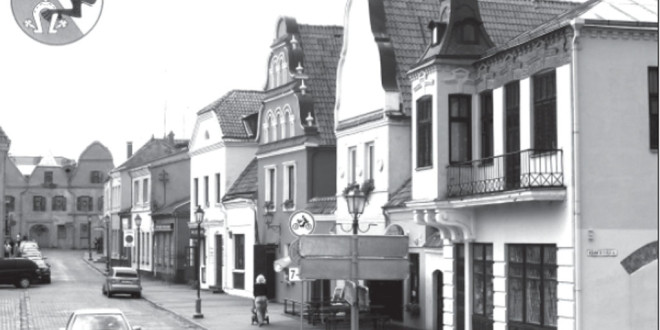Text and photos by Val Ramonis

KĖDAINIAI IS A CITY I HAD HEARD AND READ MUCH ABOUT, but never had the opportunity to visit during any of my earliertrips to Lithuania.
While in Vilnius during the Millennium celebrations at the beginningof July, I wanted to get away from the hustle and bustle of theLithuanian capital and spend an entire day exploring the historicKėdainiai region.
Accompanied by a local friend who acted as my driver and guide,we left Vilnius early in the morning.
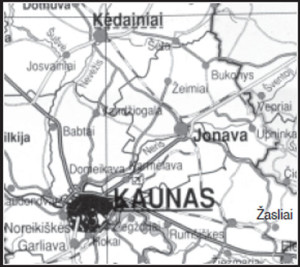
Kėdainiai is directly north of Kaunas, in central Lithuania. Andwhen I say central Lithuania, I am not exaggerating since the geographicalcenter of Lithuania is located near the village of Ruoščiai,only a couple kilometers from the city of Kėdainiai.
We took the excellent east-west Vilnius-Kaunas-Klaipėda highwayand reached the outskirts of Kaunas in little over an hour. Lithuanianhighways, and even smaller roads are some of the best in Europe.
Babtai
Before turning onto the road that would take us toKėdainiai, we stopped to visit Babtai, a small town locatedabout a kilometer from the highway. The town islocated on higher ground with a beautiful valley belowand the Nevežis river – famous in poems and songs –winding through it.
Most smaller towns and villages in Lithuania don’tdiffer that much from each other, they look pretty muchthe same: a main street with pre-World War II or olderbrightly painted houses on each side, each with a garden.Perhaps a small square with a modest monumentmarking the anniversary of the town’s founding or a memorialto those who died fighting for independence orwere deported to Siberia. That’s pretty much it.
But the churches are something else.Each one older than the other; each onelarger and more beautiful than the other.A town of 300 residents might have ahuge church built 400 or 500 years ago,full of priceless old religious art treasures.This only shows how deeplyingrained was religion in the everydaylives of Lithuanians, even if they werethe last pagans in Europe.
I would like to mention here thatduring my earlier visits to Lithuania, Iusually found the doors of most churchesunlocked. Anyone could enter andadmire the beautiful interiors with elaborately carved altarsand pulpits, beautiful paintings and sculptures, and alot of folk art. But now doors are locked, except duringtimes of services. Because of the current economic conditions,thefts from churches are more common, andpastors don’t want to take a chance. But if you have thetime, you can try locating the pastor who will gladlyopen the door and give you a tour of his church for a small donation.
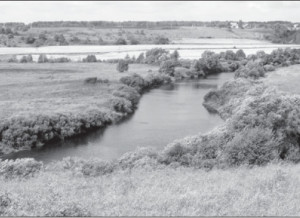
As I mentioned earlier, the most outstanding landmarkin small Lithuanian towns and villages is usually thechurch, and Babtai was no exception.
The church of Babtai, dedicated to the apostles Sts.Peter and Paul, is one of the most beautiful rural churchesI have ever seen. Freshly painted in green and red, it is a gem of wooden Baroque architecture. As is typical withmost country churches in Lithuania, the šventorius (enclosedchurchyard) has some beautiful wayside chapelsand other religious wood carvings, including one commemoratingthe 250th anniversary of the parish. Anotherlandmark in town is a monument commemorating its600th anniversary.
Today Babtai’s population is a little over 1,700, butbefore the Second World War it had fewer than 500residents. The place was first mentioned in the writingsof the Teutonic Knights who paid some unwelcome visitsto the area in 1386, and again in 1394. At that timethere were only six homesteads here. Between the end ofthe 15th century and the 18th century, Babtai was partof the Grand Duke’s possessions. During the 16th-17thcenturies the town became a busy commercial center.The first Roman Catholic church was built in 1682, andthe first parish school was already operating in 1777. In1732 Babtai was granted a privilege allowing it to hold aweekly market, and in 1792 was granted the Magdeburgcity rights and a coat of arms by Grand DukeStanislovas Augustas.
During a large fire in 1830, a large portion of the town,including the church, burned to the ground. A temporarychurch was erected soon after, and in 1853 the present church was built.
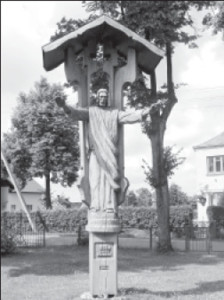
Before the advent of the railroad, the road thatran through Babtai was a busy thoroughfare forcommercial traffic between Kaunas, Kėdainiai, andRiga, Latvia.
Many of the townspeople who participated in the 1863uprising against Tsarist oppression were deported to Siberia.In 1941, and again in 1945-1953, many morewere deported to Siberia by the Soviets. In 1941, 85Jewish residents were murdered by the Nazis in the nearbyforest.—
Josvainiai
We exited the busy highway, and turned north onto asmaller road that would take us to Kėdainiai.
The next place we arrived at was Josvainiai, one of the oldest towns in the area. Josvainiai is slightly smaller thanBabtai, with some 1,550 residents, but no less historic.Prior to the Second World War its population was about500 souls.
It is believed that a castle stood here in the 14th century,which was assaulted several times by the TeutonicKnights. It is also said that during one of those assaultsin 1365, the Knights destroyed the nearby town of Labūnavaand the castle where one of King Kæstutis’grandsons resided. They took him prisoner for whichKæstutis repaid the Knights five years later by annihilatingtheir army at Rudava where 400 Knights and 26 oftheir leaders are said to have been slain. But the Knights continued their attacks on Josvainiai and Labūnava infollowing years, and marched as far as Kaunas, althoughwithout much success. The Josvainiai castle was destroyedduring the wars of the 18th century, and never rebuilt.
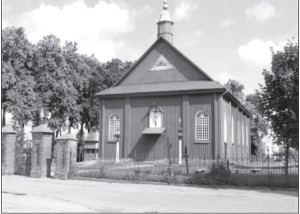
Josvainiai grew into a large town, and in 1792 wasgranted Magdeburg rights and a coat of arms. The firstchurch in town was built in 1590, and the current one,the large and beautiful red-brick Neo-Gothic All Saintschurch was constructed in 1903. What made quite animpression on me was the old well in the church’s yard.I had never seen such a thing before. Church services inLithuania tend to be longer than in the United States,and processions are usually held outdoors. I suppose parishionerscould get very thirsty walking several timesaround the church under a hot summer sun. All ruralchurches in Lithuania are surrounded by a šventorius, ayard enclosed by a stone, brick, or wrought iron fencewith an impressive gate. This is where previous pastorsand important beneficiaries and patrons are buried, andwhere processions and other services are held.
In 1812 there was a battle between Napoleon’s troopsand the Russians in the Josvainiai area where manyFrenchmen died. Many years later, locals were still findingbones and pieces of French armament and equipmentwhile plowing their fields.
Kėdainiai
We left Josvainiai and soon reached Kėdainiai, a muchlarger city with a population of about 35,000. We wentstraight to the old town section where we parked thecar. I was surprised not only by the neatness of the housesand the cleanliness of the streets, but also by the absenceof people in the streets. Houses were neatly painted inbright colors, streets were spotless clean, but hardly anypedestrians or cars could be seen. It was summer, schoolhad not started yet, but there were no children playing.No cats or dogs were visible either. A few tourists seemedto wander about, but that’s all. “Where is everybody?” –we asked ourselves. “Is this a ghost town?” The scenereminded me of some “Twilight Zone” episodes I hadseen in my earlier years. To top it off, nearby stood avery large wooden church (St. Joseph) with its exteriorpainted entirely in black. There were some nice woodcarvings in the church’s yard, including one of a whimsicalangel blowing a trumpet. Carved at the base of theangel the inscription reads: “To Lithuania’s Name – 1000[years], to the Parish – 300 [years.]”
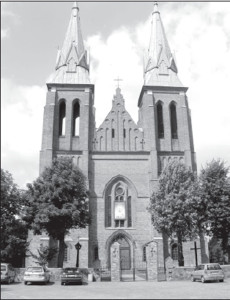
Before we started sightseeing, we decided it was timeto get something to eat, and headed for the first restaurantwe saw. The place was also empty, so we figured wewould get served quickly. Restaurants in Lithuania arenot known for fast service. As soon as we sat down at atable, the waitress warned us that anything we order from the menu would take a long, long time. When we askedthe reason, she said that a private party was being held inan adjacent room and the cooks were very busy. She suggestedthat the only thing we could get fairly quicklywere blynai (Lithuanian pancakes). We unanimouslyagreed that that’s what we would have.
Kėdainiai is situated on both sides of the Nevežis river,and is one of the oldest cities in Lithuania. It was firstmentioned in the 1372 Livonian Chronicle of Hermannde Warthberge. During the 15th-16th centuries the towngrew rapidly, became an important trade and commercecenter and one of the earliest hubs of Protestant expansionin the Grand Duchy. As a consequence, it was grantedMagdeburg rights as early as 1590, by which it gainedthe right of self-rule.
Since the 15th century Kėdainiai was the private propertyof the Radvila (Radziwill) and the Kiška familiesof magnates. The Radvilas in particular fomented theexpansion of the town by founding schools, printing houses,churches, and various other enterprises, as well asinviting craftsmen, merchants, engineers, builders, andeducators from all over Europe.
Scottish Protestants arrived in Kėdainiai in the late1500s and early 1600s encouraged by the conversion ofOna Radvila to Protestantism. The Scots exerted considerableinfluence in the city which persisted until themid-1800s.
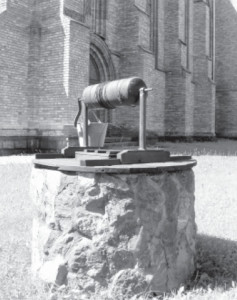
Kėdainiai has one of the few remaining original oldtowns and town halls in the country (the others areVilnius, Kaunas, and Klaipėda.)
The area around Kėdainiai was the site of many battlesduring the 17th century wars between Lithuania andRussia, as well as that with Sweden (called “The Deluge.”)In 1655 a short-lived treaty with Sweden, theUnion of Kėdainiai, was signed by two members of theRadvila family in their Kėdainiai castle. While little ofthe Radvila castle is left, the cellars of the EvangelicalReformed Church (built in 1631-1652) houses the family’smausoleum, where the remains of six Radvilamembers are laid to rest.
The 18th and most of the 19th century also saw wars,fires, plagues, and uprisings ravaging the city, which didnot recuperate until the end of the 19th century whennew industries developed, including leather and cardboardfactories, mills, a brickyard, and a dairy.
Kėdainiai suffered extensively from destruction and firesduring the First World War and the following battlesfor Lithuanian independence. In 1940-1944 the Sovietand Nazi occupations also did great damage to Kėdainiai.Many citizens from the city and the region wereexiled to Siberia. The Jewish community that had existedfor longer than 400 years was destroyed by the Nazis.
During the Cold War, the city was home to the Kėdainiai air base, a major military airliftfacility. In 1991, during the Sovietarmy’s attack in Vilnius (“BloodySunday”), two Kėdainiai residentswere killed. They were buried in thecity’s cemetery and two of the city’sstreets were named after them.
For many years, Kėdainiai wasknown for its chemical and foodprocessing industries. The KėdainiaiChemical Plant began operations in1963. Publicized as a milestone in theindustrialization of Lithuania, it emittedsignificant quantities of sulfuricacid and was the subject of ecologicalprotests and demonstrations in the1980s. Following years of stagnation,old enterprises have come back to life,and new ones have been established,contributing to Kėdainiai’s status asan economic stronghold.

Since the 19th century the city hasbeen known as the “Cucumber Capital”of Lithuania, and it holds andsponsors an annual cucumber festival.One of the city’s main industriesand a major place of employment isa food processing and packing plant,owned by a Russian-born politician,where not only cucumbers are pickled,but other foods are also producedfor both local consumption and export.
Kėdainiai is a wonderful city to visitwith many interesting cultural, religious,and historical sites. The smallbut very attractive old town has four old market squares,numerous Catholic, Protestant, and Orthodox churches,a Jewish synagogue complex, a minaret, many interestingmuseums, ancient cobblestone streets, 17th-19th centuryhouses with Renaissance, Baroque and Classicaldetails, and various monuments and memorials honoringfamous persons and events. We certainly could notvisit all of them in a few hours; we would need a wholeday.
But we did visit a few, such as the Kėdainiai RegionalMuseum, housed in a former Carmelite monastery. Themuseum has fabulous exhibits of weaponry, portraits ofrulers of Kėdainiai, furniture made out of antlers, folkart, and historic artifacts from the area dating back toprehistoric times.
We also visited the Janina Monkutė-Marks MuseumGallery.Monkutė-Marks is a Lithuanian American from the Chicago area who created a non-profit foundationwhich purchased and restored an old Kėdainiai manorhouse that was renovated and converted into a museumbearing her name. In the museum you can see a permanentexhibit of her paintings, textiles, and rugs. It alsoholds periodic exhibits of other Lithuanian and foreignartists and engages in educational programs.
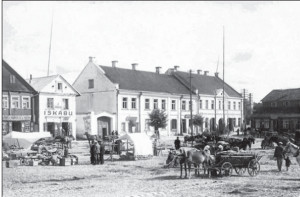
One of the Catholic churches we visited was St.George’s, sitting on a steep hill across the Nevėžis riveropposite the old town. Built in 1445-1460, the Gothicchurch was the first brick building in Kėdainiai, and isone of the oldest churches in Lithuania. From the hillwe could see a very nice view of the river and the city.
Perhaps the jewel of all the sites we visited is the EvangelicalReformed church. Constructed in 1631-1652, itis a splendid Renaissance-style structure with Baroquetowers. It looks more like a stronghold. The cellar of the church contains a family mausoleum of the Dukes Radvila.It is the only reconstructed burial site of high-rankingnobles in Lithuania.
The church was began by Kristupas Radvila “The Thunderer,”and completed by his son Jonušas Radvila theEleventh. It has the original beautifully carved oak pulpitwith intricate designs. During the Soviet occupation,the church was used as a basketball court.
We walked down to the cellar where we could see therichly ornamented metal caskets containing the remainsof six Radvila members, including four children, theyoungest less than a year old, and the oldest only fouryears of age at the time of their deaths. Those buriedthere are Kristupas Radvila “Perkūnas” – “The Thunderer”(1547-1603), his grandson Jonušas Radvila(1612-1655), Mikalojus Radvila (1610-1611), JurgisRadvila (1616-1617), Steponas Radvila (1624-1624), andElžbieta Radvilaitė (1622-1626). A large and very unusualmonument to the Radvilas and their legacy inKėdainiai was recently erected in the center of old town’smain square.
From its beginnings Kėdainiai was an important political,cultural, religious, and economic center. It wasgiven Magdeburg city rights as early as 1590.
During the 16th-17th centuries, it was a booming cosmopolitanmetropolis with no fewer than 6 ethnic and 6religious communities. It had one of the largest Scottishcommunities in the entire Baltic and Scandinavian region(some say as large as 50 percent of Kėdainiai’spopulation), as well as a large German community. ItsJewish community was the largest in the entire Žemaitijaregion.
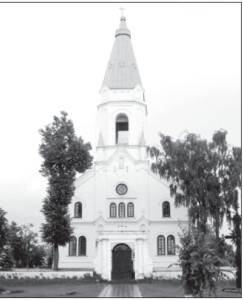
When I returned home, I read some comments on theInternet by other tourists who had visited Kėdainiai. Onethat caught my attention was exactly what I had experienced:“I found the old town of Kėdainiai very beautiful,safe and clean. But what surprised me most, there werealmost no people walking along Didžioji – the old town’smain street in the afternoon on Saturday. There werealmost no cars around the old town either. Another ghosttown? Why? I have no idea. Kėdainiai has approx. 35,000citizens as I checked. Instead there were many renovatedbuildings, painted in various colors. Take time, walk alongthis street, stop to shop, eat and/or drink if you want.”But another visitor remarked that, “the old town is theonly nice place in Kėdainiai. The rest of the city is prettyrundown, with many dilapidated Soviet-era apartmentbuildings with broken windows.” Perhaps so, but thesections we visited looked very good. Could it be that inorder to attract visitors, the local government has goneout of its way to make the city’s historic old town asclean and attractive as possible? If that’s the case, theydeserve my applause.
Sėta
Time was flying, so we decided to head back to Vilniusby a different route. From Kėdainiai we turned east ontoa road that would lead us through Sėta, a smaller townwith a population of 1,025 (it had 1,350 residents beforeWW II.)
The area around Šėta was devastated by the LivonianKnights in 1362 and again in 1367. It is believed that atabout that time some Karaims, a Turkic-Jewish ethnicreligiousgroup from the Crimea, settled in the area. The town itself is known since 1492. The first Roman Catholicchurch was built in 1499, but it later passed into thehands of Protestants.
The town grew, and by the 18th century it had marketand commercial privileges, but was devastated byseveral fires and by Sweden’s invasion of Lithuania duringthe Northern War. The Swedes not only destroyedthe entire town, but razed it to the ground so that novisible signs of it would remain.
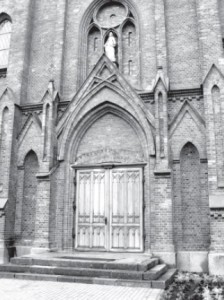
Sėta was eventually rebuilt, and by 1777-1779 it had anew church, a parish school, and many other buildings,but most of it was destroyed or burned again during theFirst World War by German artillery while attackingRussians positions.
The area around Šėta was also the site of fighting betweenLithuanian and Bolshevik armies during the yearsfollowing World War I. It was near Šėta where Povilas Lukšys, the first volunteer soldier to die for Lithuania’s independence was killed. He is buried in the Kėdainiai Cemetery.
Today Sėta seems like a fairly ordinary town, as are many such small towns in Lithuania. The white Holy Trinity church, built in a mixture of architectural styles, is not as large as some of the other churches we saw on our trip. The cross on its bell tower must have been hit by lightning since it was leaning to one side.
Zeimiai
From Sėta we turned south toward Zeimiai, another very old town with some 960 residents (it had 500 before WW II.) The historian Motiejus Strykovskis (1547-1593) described a battle fought in the vicinity of Žeimiai in 1319 between King Gediminas and the Teutonic Knights. A more reliable source mentions the town’s name for the first time in 1363. That year, a combined army of Teutonic and Livonian Knights devastated the area. The town was mentioned again in 1365, 1379 and in 1384.
In 1522 the first Roman Catholic church was built by the magnates Zaviša. In 1565 the church fell into the hands Protestants, but Catholics regained it in 1631. The church was expanded in 1720.
Žeimiai was the earliest cradle of Protestantism in Lithuania. The first Evangelical Reformed parish in Lithuania was founded here in 1542, and a parochial school was already operating in 1595. A book printing shop was also set up here where in 1605 a Protestant Catechism was published.
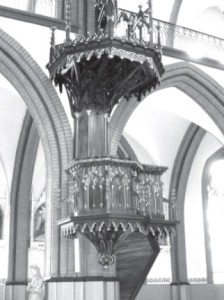
The present Catholic church, Nativity of the Blessed Virgin Mary, was built in 1906. It is a magnificent NeoGothic red-brick structure with a beautiful portal, very similar to the one in Josvainiai. This is one of the few churches we found unlocked, so we went inside. As is the case with most churches in Lithuania, the interior is magnificent, with large colorful stained-glass windows, a beautiful altar, and a most striking intricately carved oak pulpit with gold highlights. There was no service at the time, and no one else was inside, so we were surprised to find the church open. But there were some people mingling outside, perhaps waiting for the services to begin.
Žeimiai was also a large center of resistance during the 1831 uprising against Tsarist rule. General Antanas Gelgaudas, one of the leaders of the uprising, had his headquarters here and issued some proclamations.
After leaving Žeimiai, we took a road heading in a southeasterly direction. In the distance we could see the skyline of Jonava, a much larger city with some 35,000 residents (before WW II it had only 5,000.) Another 17,500 live in nearby villages. Because it was getting late, we decided to bypass it for now.
Further east, we passed Rukla, a smaller town (population 2,370). Rukla is the site of a Lithuanian military base, where three army units are stationed. It has training grounds, firing ranges, and other installations.
Zasliai
Our last stop before getting onto the Vilnius-Kaunas-Klaipėda highway that would take us back to the Lithuanian capital was Žasliai, a small but very charming town with some 800 residents.—Žasliai is one of the oldest and most historic places in Lithuania. It is also one of the more picturesque, with a stream crossing the town and three lakes bordering it. It is a favorite spot of vacationers and fishermen. While the town’s name was first mentioned in 1457 (it celebrated its 550 anniversary in 2007), it is known that already during the reign of Vytautas the Great (1401- 1430), the village of Žasliai belonged to Duke Jaunius Valimantaitis, and later to the Vaičius and the Goštautas families of magnates. The first church was built in the mid-1400s, and the present one, St. George, in 1902.
In the 16th century the town passed into the possession of Grand Duke Žygimantas Augustas, who gave it to his young wife Barbora Radvilaitė.
In 1571-1573, a plague decimated many of the town’s residents, and in 1655 the Russian army devastated the area and burned most of the town. Another plague in 1710 reduced the town’s population to a little more than 100.
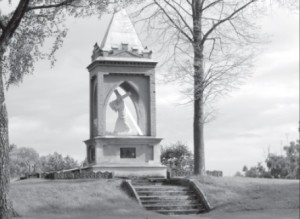
The first school was already operating in 1777, and in 1792 Žasliai was granted the Magdeburg city rights and a coat of arms by Grand Duke Stanislovas Augustas. At that time there were 376 residents in town, and all houses were still made of wood. But it began to grow, and by the first part of the 19th century it had become an important cultural, political, and economic center. It is recorded that in 1833 the town had a flour mill, a liquor producing plant, 15 taverns and 6 other stores. It also had a very large Jewish community, comprising almost 70 percent of the town’s population, with three synagogues, a school, a library, a bank, a fire brigade, and several organizations.
Žasliai is the birthplace of several noted Lithuanians, among them the late Cardinal Vincentas Slatkevičius. It was also used as the setting for one of Lithuania’s most famous motion pictures, “Tadas Blinda.”
St. George’s church stands on a hill overlooking the lake, and the view from the church’s yard is truly magnificent. Once someone said: “There are many beautiful places, but the most beautiful of them all is the view from the Žasliai churchyard where the sky blends into the lake’s waters.”—
I would tend to agree, although I don’t know when this person made the remark; it could have been decades ago. Unfortunately, when I was there the overgrown trees prevented me from viewing the scene entirely and taking a good photograph.
The church is a very large red-brick Neo-Gothic structure very similar to the ones we saw in Josvainiai and Žeimiai. They were all built about the same time. In the church’s yard stand a number of wood carvings, statues, and shrines, including a beautiful chapel with a full-size figure of Christ carrying the Cross.
Shortly after leaving Žasliai we got onto the busy highway and headed east toward Vilnius. In a little more than a half an hour we were back to where we started from. This trip was a wonderful way to spend a day and a great experience. You learn so much by getting away from the large cities and exploring the country with its little towns, villages, and historic places. My only regret is that we didn’t have enough time to see it all, particularly all of the interesting sites in Kėdainiai. I promised myself to return some day and spend an entire day in this beautiful city. If you haven’t been there yet, you should make a point to visit it the next time you are in Lithuania. You will not be disappointed.
 DRAUGAS NEWS Lithuanian World Wide News in English
DRAUGAS NEWS Lithuanian World Wide News in English
